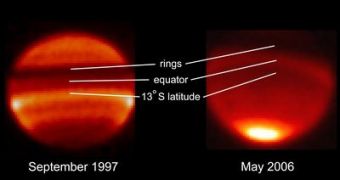The discovery comes in the outcome of 22 years of continuous observations of the temperature variations of the second biggest planet in the solar system, Saturn, which has been the subject of the longest temperature study ever conducted on an extraterrestrial body. Similar atmospheric temperature oscillations have been recorded in our planet's atmosphere (it occurs every two years), in Jupiter's upper atmosphere (every four Earth years), while Saturn's cycle requires 15 years to complete.
All three oscillations seem to follow the same general pattern, suggesting that the planets must have some kind of common link. The two decade long study has been conducted by Glenn Orton from NASA's Jet Propulsion Laboratory in Pasadena and will probably continue until the end of the current Saturnian year, which takes 30 Earth years to complete.
"You could only make this discovery by observing Saturn over a long period of time. It's like putting together 22 years' worth of puzzle piece, collected by a hugely rewarding collaboration of students and scientists from around the world on various telescopes", Orton said.
This atmospheric oscillation pattern is expressed through a temperature variation within the upper layer of Saturn's atmosphere according to altitude. The changes in temperature determine periodical wind direction variations from east to west, making the entire region seem to oscillate like a wave.
Cassini's Composite Infrared Spectrometer instrument picturing these temperature patterns showed that temperature variations across the equator of the planet swing from hot to cold and vice versa every half Saturnian year or so, meaning 15 years. "It's this great synergy of using ground-based data over time, and then getting up close and personal with the oscillations in Saturn's atmosphere through Cassini. Without Cassini, we might never have seen the structure of the oscillation in detail", says Cassini Composite Infrared Spectrometer lead investigator and co-author of the study, Mike Flasar.
The temperature changes seem to be taking place only when the Sun is directly above Saturn's equator, although further studies with the Cassini spacecraft orbiting around the planet could reveal whether or not the phenomenon is related in any way to the seasons.

 14 DAY TRIAL //
14 DAY TRIAL //